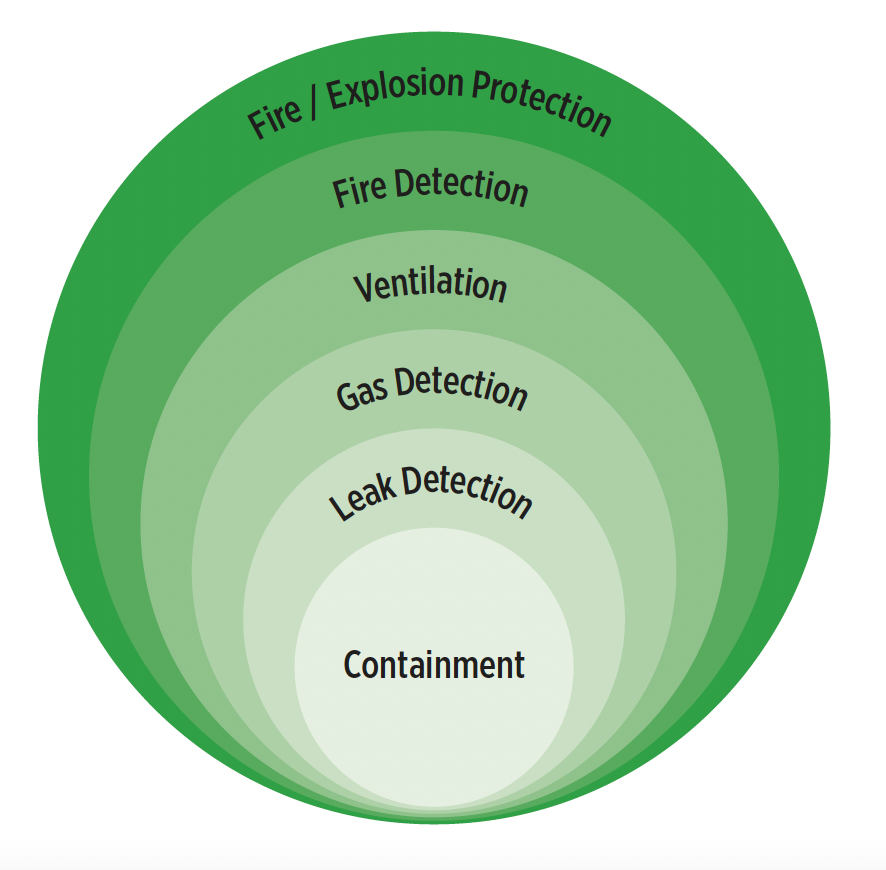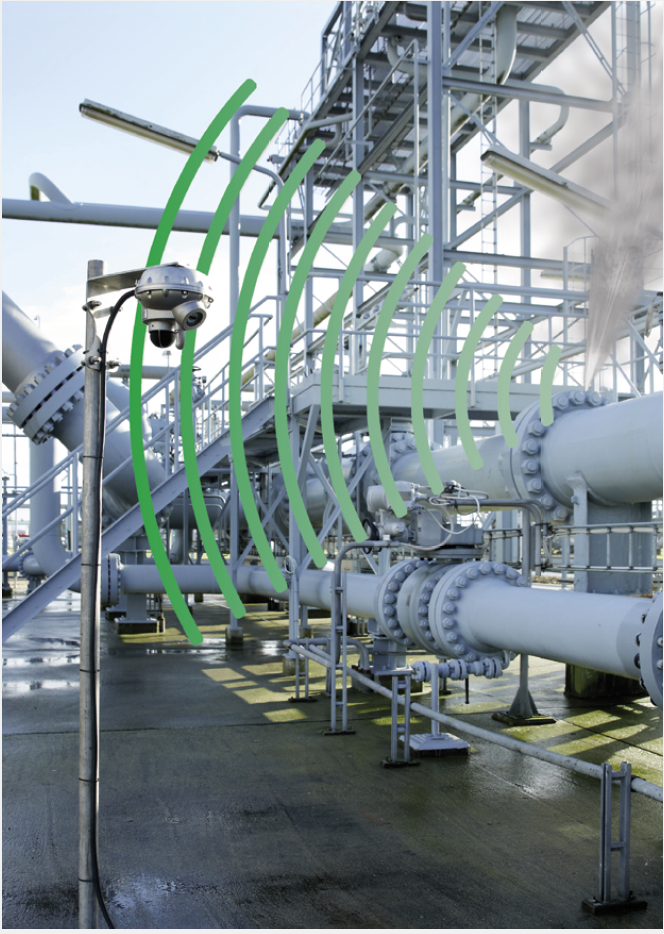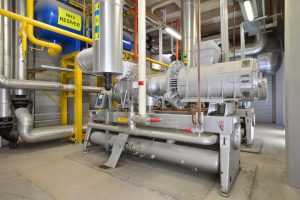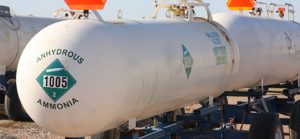The adoption of hydrogen as a clean, zero-carbon renewable energy source promises a global revolution, eliminating harmful emissions responsible for climate change. This white paper explores the opportunities and implications of an emerging hydrogen society. MSA Safety examines workplace safety risks and challenges posed when producing, handling, transporting, and storing alongside suggested best practices, safety measures, and detection technologies.
Introduction to Hydrogen
Decarbonisation is now a global imperative. At the 2021 United Nations Climate Change Conference (COP26), 64 countries (accounting for 89% of global carbon dioxide (CO₂) emissions) made net-zero pledges. According to McKinsey, by 2050, electricity and enabling hydrogen and synfuels could account for 50% of the energy mix.1
From an environmental and sustainability perspective, moving to hydrogen as a fuel source is extremely attractive. Whether hydrogen gas is used to produce heat through combustion, or chemically reacted with air in a fuel cell to create electricity, the only by-product is water.
In contrast, burning fossil fuels releases multiple harmful emissions: greenhouse gases such as carbon dioxide (CO2) and nitrogen oxides (NOx), and solid micro particulates which can be highly toxic.
Comprising some 75% of the elemental mass in the universe, hydrogen is the third most abundant element on the Earth’s surface after oxygen and silicon. Hydrogen molecules are everywhere – bound up in our plants, in our rainwater, lakes, and oceans, and in waste bioproducts such as methane gas, animal slurry, and human waste.
1 Global Energy Perspective 2022, McKinsey report
Table of Contents

Harvesting hydrogen: an industrial process
Hydrogen can be produced through various processes; each uses different amounts of energy and causes different emissions, including different carbon footprints. To produce hydrogen gas, the chemically bound hydrogen molecules must be liberated from existing compound sources such as those mentioned earlier. Such liberation requires energy or other processes, which can have different impacts on the environment. Below we explore three examples of the processes currently available.
First, steam reforming can be used to split natural gas or methane into hydrogen and CO2. Most hydrogen gas from chemical plants and oil refineries uses this process to produce ‘grey hydrogen’, so called because it releases around 10 kg of CO2 for every 1 kg of hydrogen produced.
Second, ‘blue hydrogen’ is formed in the same way but captures and stores most of the CO2 underground to reduce greenhouse gas emissions.
Third, the cleanest current process uses electricity from renewable sources such as wind, solar, and hydropower to split water molecules into hydrogen and oxygen via electrolysis. This creates carbon-free ‘green hydrogen’ which is an attractive energy source for industries striving to decrease emissions using cleaner technologies including the steel, glass, and cement industries.
Hydrogen fuel applications: exciting opportunities
Hydrogen has the exciting potential to provide alternative clean energy solutions for many industrial processes, transportation, and domestic energy applications currently reliant on burning fossil fuels. Already, automotive OEMs and others have developed groundbreaking hydrogen fuel cell powertrains and this technology is increasingly appearing in zero-emission cars, buses, light and heavy goods vehicles, and even ships and trains. Hydrogen also represents a potential zero-emission alternative fuel source to natural gas and oil for domestic heating and hot water, especially significant given the ambitious global net zero emission targets.
Hydrogen storage and distribution
For most applications, hydrogen is stored as a gas. At normal atmospheric pressure, hydrogen gas occupies a high volume. For this reason, and to make it easier and cheaper to transport and store, hydrogen gas is often compressed in high-pressure tanks at 350–700 bar [5,000–10,000 psi]. Alternatively, hydrogen can be stored or transported as ammonia as this has a higher storage density, and then converted to hydrogen later. To store hydrogen as a liquid, it must be cooled to a temperature below -252.8ÅãC. As this requires highly insulated tanks and specialist cryogenic equipment, liquid hydrogen fuel is currently only used in a limited number of applications. And while solid hydrogen storage solutions are possible there is still a lot of research to be done to make them viable for mass use. Therefore, gas typically remains the simplest option for hydrogen storage at this time.
Existing infrastructure, such as natural gas pipelines and networks, would need to be adapted before it could distribute hydrogen from production centers to distribution hubs, refueling stations, and places of use. Similarly, hydrogen can be stored in bunkering stations to supply shipping with fuel.
Hydrogen can also degrade certain materials such as commonly used metals and plastic and can make them brittle and more prone to leaking. For this reason, hydrogen storage tanks are usually constructed from stainless steel or, increasingly for transport applications, weight-saving composite tanks.

In the UK, Health and Safety Executive (HSE) Dangerous Substances and Explosive Atmospheres Regulations 2002 (DSEAR) place duties on employers to eliminate or control all the risks from explosive atmospheres in the workplace.
Two European ATEX directives outline minimum safety requirements for workplaces and equipment used in explosive atmospheres.
ATEX guidance focuses on the hazard of explosive atmospheres occurring in the workplace due to the presence of flammable gasses or combustible dust mixed in air and minimizing the risk of explosion. The first, Directive 99/92/EC (‘ATEX 153’ or the ‘ATEX Workplace Directive’) covers requirements for improving the health and safety protection of workers potentially at risk from explosive atmospheres. The second, Directive 2014/34/EU (‘ATEX 114’ or ‘the ATEX Equipment Directive’) concerns equipment and protective systems intended for use in potentially explosive atmospheres.
For gases, hazardous areas are classified into three categories. This is the primary method used throughout the world to indicate the probability of the explosive hazard being present:
ZONE 0
A hazardous area in which a flammable atmosphere is continually present or present for long periods.
ZONE 1
A hazardous area in which a flammable atmosphere is likely to occur in normal operation.
ZONE 2
A hazardous area in which a flammable atmosphere is not likely to occur in normal operation and, if it occurs, will exist for a short period.
Areas that fall outside these categories, where no flammable atmospheres are expected, are deemed non-hazardous.
Additionally, electrical equipment for these explosive atmospheres is divided into groups.
GROUP I
Reserved for the mining industry.
GROUP II
Reserved for surface industries with gas hazards, and is subdivided into IIA, IIB, and IIC.
The subdivision of the gases in the Gas Groups is based on the Minimum Ignition Energy with which an electrical spark can ignite the gas mix. Gases in Gas Group IIC where hydrogen is, require the lowest ignition energy to ignite, making it one of the most dangerous gases in this classification system.

Hydrogen Safety
As growing numbers of industries embrace the use of hydrogen it is important that the hazards of working with this fuel are understood, and the right safety measures and systems are put in place. While hydrogen is safer to handle than some other commonly used fuels (in that it disperses quickly in air and is not toxic), it is still highly combustible and is an asphyxiant gas. Its unique properties also pose special challenges, which is why, in addition to general fuel safety regulations, there are specific regulatory requirements for those working with hydrogen.
What to consider when working with hydrogen
Hydrogen’s chemical properties pose unique challenges. Specifically:

The gas is not visible to the eye and has no odor, making it undetectable by human senses.

Hydrogen is lighter than air. It is commonly understood that in confined areas it will rise upwards to ceiling level displacing oxygen, making it difficult to detect in spaces where accumulations cannot occur. However, pressurized hydrogen gas leaks can be hard to detect as the gas jet direction can be unpredictable, making detector positioning difficult.

When mixed with air hydrogen is highly combustible. However, a pure hydrogen flame is very pale and almost invisible in daylight and fails to register with traditional heat detectors.
Fire, explosion, and asphyxiation are the main safety considerations associated with handling hydrogen, especially considering wide flammability range of 4% to 77% of volume in air. The main areas of risk can be categorized as shown in Figure 1 below:
Figure 1: The main areas of risk associated with handling hydrogen
Propensity to leak
- Small molecular size and permeation properties
- Extremely high diffusivity
Propensity to ignite
- Very low ignition energy
- Fast detonation
- Wide flammability range
Fire consequences
- Invisible flame with low thermal radiation
- High flame temperature
Human related
- Potential injury or loss of life
- Colourless, odorless and tasteless gas
Planning detection: standards, strategies and solutions for sites handling hydrogen
Explosion protection is currently governed internationally by the IEC 60079 and IEC 80079 standards, with many regions adopting almost
identical standards locally. Additionally, specific standards for hydrogen facilities are also available, for example:
ISO 22734 – Hydrogen generators using water electrolysis — Industrial, commercial, and residential applications: manufacturers of electrolysers are required to perform a risk assessment. However, depending on the final placement location of the equipment, plant owners/operators may need to perform their own additional assessment on the hydrogen generator, applying zone classification using IEC 60079-10-1 or an appropriate national standard.
ISO 19880 – Gaseous hydrogen — Fuelling stations: sites must be inspected in accordance with the IEC 60079-10-1 standard or sufficient national regulations. This includes zone classification and ignition protection methods to IEC 60079 and IEC 80079.
Both standards also specify requirements for risk mitigation with a gas detection system as one of the methods to prevent the accumulation of ignitable gas mixtures.
The need for layered fire and gas protection
Hydrogen’s minimum ignition energy in air at atmospheric pressure is approximately 0.02 mJ. In the case of a hydrogen gas leak, especially in a confined space, a static electric discharge from a worker’s clothing or equipment could result in an explosion or fire.
Coupled with the physical properties highlighted earlier a robust and layered strategy for fire and gas detection is needed (Figure 2), supported by plume modeling and gas mapping to demonstrate the effectiveness of a hydrogen detection system.
Key challenges for any site handling or storing hydrogen, such as an electrolytic hydrogen production plant or hydrogen fueling station, include detecting leaks outside, where the gas can’t accumulate and installing detectors appropriately within different risk zones.
To detect any loss of hydrogen containment therefore requires the application of several distinct, yet complementary, technologies spanning ultrasonic leak detection, conventional gas detection, and flame detection.
Figure 2: Layered fire and gas protection

Ultrasonic detection of hydrogen leaks
When pressurised hydrogen gas leaks, it generates an ultrasonic sound at the exit point. Ultrasonic monitors detect airborne ultrasound produced by turbulent flow above a predefined sound pressure level. Depending upon the level of background ultrasound, a single detector can respond to even a small hydrogen leak some distance from the source.
Since ultrasonic detection does not rely on a presence or concentration of hydrogen gas, and is unaffected by wind or plume direction, it is ideal for monitoring pressurised pipes and vessels (e.g. open well-ventilated areas of storage facilities ranging from large production sites to smaller fueling station). Instruments can alarm rapidly as the time it takes for ultrasonic noise to travel from the leak source to the detector is typically measured in milliseconds.
Lorem ipsum dolor sit amet, consectetur adipiscing elit. Ut elit tellus, luctus nec ullamcorper mattis, pulvinar dapibus leo.
Low and combustible hydrogen levels: point gas detection
Point gas detectors for hydrogen use either catalytic or electrochemical sensors.
In catalytic gas detection, gas enters the sensor through a sintered disc (flash-back arrestor) and comes into contact with pellistors (beads) and is oxidised. A sensor uses a Wheatstone Bridge which converts the resulting change in resistance into a corresponding sensor signal, proportional to the amount of gas present. Results are read either locally via display on the device or remotely at a control unit located in a safe area. The operational range of these sensors is in the range of 0-100% LEL.
Electrochemical sensors use an electrochemical reaction to generate a current proportional to the gas concentration. The sensor is a chamber containing a gel or electrolyte and electrodes. The gas sample enters the casing through a membrane; oxidation occurs at the working electrode and reduction takes place at the counter electrode, resulting in ions flow which creates a current. Measurement of this current is converted into a displayed gas reading.
The operational range of electrochemical cells for the detection of hydrogen is more sensitive than catalytic sensors – typically 0-1000 ppm. This makes electrochemical gas detectors well-suited to areas where hydrogen gas would be contained within an enclosure e.g., within a compressor housing where the very earliest detection of a release with small gas concentrations is usually required or sought.
Hydrogen flame
detection
In the event of a fire resulting from an undetected gas leak due to, for example, incorrect gas detector placement, selection, or sensor failure, hydrogen-specific flame detectors provide a warning to deploy fire suppression and other safety actions.
Detectors simultaneously monitor infrared (IR) and ultraviolet (UV) radiation at different wavelengths. When hydrogen burns, radiation is emitted in the infrared spectrum by hot water molecules or steam created by combustion. An algorithm that processes IR radiation modulation reduces false signals caused by hot objects and solar reflection.
The UV detector is typically a photo-discharge tube that detects deep UV radiation. The key benefit of using current UV and IR sensors within a single instrument is the only alarm source shared between the two sensing technologies is a real fire.
Due to absorption by the atmosphere, solar radiation at certain wavelengths does not reach the earth’s surface, eliminating alarms from solar radiation when the appropriate range is monitored. This combination of IR and UV detection improves speed of response, and false alarm immunity while producing detectors that can detect even small hydrogen fires.
Detectors: zones, placement and fire and gas mapping
Correct placement and utilization of multiple detector technologies increase the likelihood of identifying hydrogen gas dispersal or fire, early. Suggested locations may include but are not limited to:
Areas where leaks are possible and gas can accumulate
Connections that are frequently separated (e.g. hydrogen refueling connections)
Building air intake and exhaust ducts drawing possible leaks into or outside the building
Ultrasonic detectors ‘listening’ for leaks can be placed wherever background noise or large structures won’t impede the detection of the ultrasonic sound.
Presently, hydrogen detection schemes are mainly based on point gas detectors, either with catalytic-bead or electrochemical-cell type sensors. Users should be aware that the likelihood of hydrogen gas detection by point gas detectors can be quite poor for applications in unconfined areas. This is as hydrogen gas in processes or storage is usually under elevated pressures, and the direction of the leaked hydrogen plume is not necessarily upwards.
Hydrogen flame
detection
When under pressure, hydrogen gas leaks are likely to be in the form of gas jets. The shape of these jets is typically long but narrow in width, and the momentum of release can maintain this shape for a considerable time. This increases the likelihood of the gas jet bypassing point gas detectors for a lengthy period. And, since it is difficult to know where a leak would occur, the direction of such gas jets is typically random. This increases further the likelihood of delayed detection or in the worst case the likelihood of no detection.
Positioning point gas detectors for rapid hydrogen gas detection in unconfined areas is difficult. Consequently, the likelihood of hydrogen gas detection can be much lower than realized.
Plume modeling and gas mapping software tools can be used to demonstrate the limitations of point gas detectors in hydrogen gas applications and help bring into urgent consideration new detection techniques, like ultrasonic gas leak detection, for more effective hydrogen gas risk mitigation.
Worker protection: portable gas monitors and area monitors
Workers may need to access areas of a site where sensors are not installed. In an enclosed space, the risk of a potential hydrogen leak causing worker asphyxiation is generally outweighed by the danger of combustion caused by static from clothing, footwear, or equipment causing an explosion or fire. Therefore, the focus is on portable detection and atmospheric monitoring using portable gas detectors and area monitors.

MSA and Hydrogen
Choosing a vendor for hydrogen detection and safety
As shown, hydrogen gas detection and monitoring poses several unique challenges. Organisations engaged in or entering the hydrogen supply chain should seek guidance from a safety partner with a proven track record backed by sector-specific insight and expertise.
As one of the world’s largest and most experienced global suppliers of gas and flame detection equipment, MSA Safety has pioneered the detection of combustible gases like methane and propane. With an in-house R&D team, MSA develops, tests, and manufactures its own fully certified portfolio of products and safety solutions, including the very latest hydrogen gas and flame detection technologies.
MSA: pioneering hydrogen detection technology
Supporting hydrogen safety in demanding applications
On the International Space Station (ISS), MSA catalytic-bead gas sensors are currently part of an Advanced Hydrogen Sensor Technology Demonstration testing alternative technology to detect the presence of excess hydrogen. The ISS oxygen generation system (OGS) uses electrolysis to produce breathable oxygen and hydrogen sensors check that none of the hydrogen enters the oxygen stream into the cabin, but current monitor devices are sensitive to humidity and have a limited lifespan. After years of successful ground testing, new MSA sensors are being evaluated to determine their stability over time.
Going further back, in the 1950s and 60s an MSA subsidiary developed a hydrogen sensor for NASA’s Project Gemini to protect workers and astronauts from explosions and fires. MSA also played a role in Project Mercury, designing canisters to absorb the carbon dioxide, and helped develop respiratory protection for Apollo Program astronauts.
Gas detection solutions with innovative sensing technologies
As part of layered protection, MSA XCell. catalytic combustible sensors also employ components that increase sensitivity, reliability, and service life, providing a 5-year lifetime and 3-year warranty. Careful matching of the active and reference elements (“beads”) in a Wheatstone Bridge circuit result in a sensor that has negligible zero drift with respect to changes in humidity, pressure and temperature. Consequently, this sensor maintains baseline stability over a wide temperature range with minimal zero drift.
MSA also supplies globally certified controllers which can automatically execute the required and approved sequence of safety actions needed in the event of a leak or fire within complete gas and flame detection system. The design flexibility through customized solutions allows them to meet customers’ gas monitoring need for growing new hydrogen applications. Such systems are built to customer specifications and combine the advantages of various MSA instruments and sensors with our electrical and mechanical engineering expertise.
Hydrogen leak detection “At the Speed of Sound”
A global pioneer in the development of ultrasound for gas detection, MSA’s latest third-generation ultrasound technology features Artificial Neural Network (ANN) algorithms to detect hydrogen. Using advanced sound processing, the Observer discerns between a gas leak noise event and unwanted background noise, matching omnidirectional acoustic readings with data recordings amassed over a decade from both onshore and offshore facilities in the field. In contrast to earlier generations of ultrasonic detectors listening only at frequencies over 25 kHz, the Observer-i monitors down to 12 kHz without picking up the unwanted background noise. This lower frequency range significantly increases the detection radius while maintaining a reduction in false alarms.
The Observer-i requires no alarm set points or trigger levels to be configured, and no time-consuming “training” sequences before installation. For failsafe operation, a patented self-test function, Senssonic™, runs integrity checks every 15 minutes. The unit provides accurate identification and detection of hydrogen gas leaks from 2 bar (29 psi) pressure, from distances up to 28 meters, at the speed of a sound.

Safety without compromise: best practice fire and gas mapping and planning with MSA
In summary, hydrogen gas presents exciting commercial and sustainability opportunities – and several new and distinctive challenges across the production and distribution chain. Design, installation, and planning of a layered gas and flame detection system for process industry facilities usually begins with choosing the correct instrumentation for the specific potential hazards, as well as determining sensor detection range, mounting, and positioning, field of view, knowledge of lines of sight, and blind spots. Quantifying flame and gas risks to correctly position fixed gas & flame detectors for the highest detection coverage benefits from careful analysis and a systematic approach. Plume modelling and gas mapping can provide valuable insights into the effectiveness of an applied hydrogen detection scheme.
Through its fire and gas mapping solution, MSA offers a technical assessment of a facility coupled with mapping software to provide metrics calculation based upon the technical report’s findings. The software informs optimal sensor placement and determines the location and scope of gaps in coverage targets. Coverage calculations provide a quantitative measure of gas detection needs that complement conventional methods. A mapping report includes graphical maps of residual risks, recommended detector placements, and numerical estimates of detection coverage. The approach used is based upon recommendations outlined in ISA’s TR84.00.07 Technical Report.
For advanced maintenance tasks, where distances are greater and time in the confined space is extended and for rescue applications, Self-Contained Breathing Apparatus (SBCA) provides the independent air supply and unrestricted mobility required. Some of the best in-class SBCA equipment for confined space use has derived from manufacturers working on solutions for firefighters. Cutting-edge features to look for include a compact and lightweight design, and real-time wireless monitoring of the user with smart data gathering.
DOWNLOAD THE WHITE PAPER

Managing Ammonia Gas Leaks in the Refrigeration Industry
Discover the hazards of ammonia gas leaks in refrigeration. Learn about advanced detection solutions and safety strategies to protect workers and ensure compliance.

Ammonia Gas Leak Detection: Essential Safety Guide
This whitepaper considers the different Confined Space Entry (CSE) challenges, highlighting features and characteristics that define best-in-class practices and solutions.

Navigating Hydrogen Safety
Take a closer look at the challenges posed by hydrogen leaks, the risks involved and the need for precautionary measures to ensure the safe adoption
